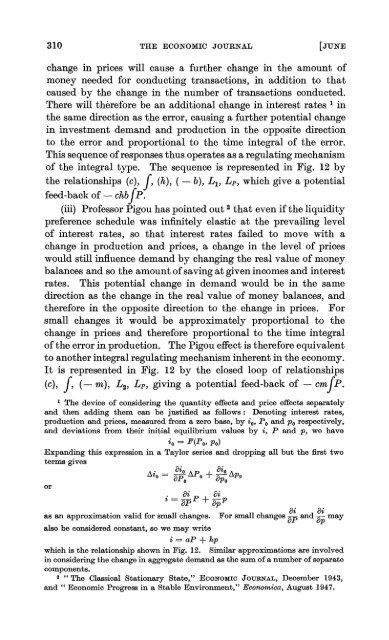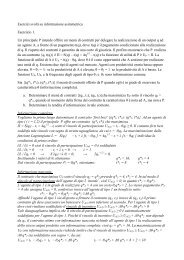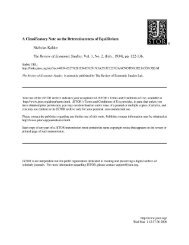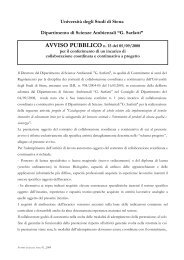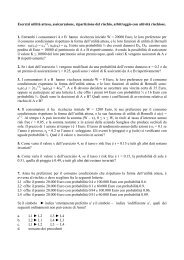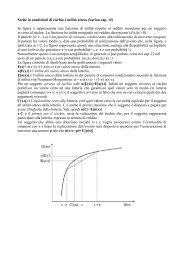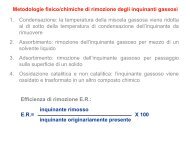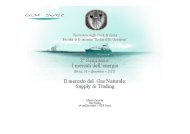Stabilisation Policy in a Closed Economy Author(s): A. W. Phillips ...
Stabilisation Policy in a Closed Economy Author(s): A. W. Phillips ...
Stabilisation Policy in a Closed Economy Author(s): A. W. Phillips ...
You also want an ePaper? Increase the reach of your titles
YUMPU automatically turns print PDFs into web optimized ePapers that Google loves.
310 THE ECONOMIC JOURNAL [JUNE<br />
change <strong>in</strong> prices will cause a further change <strong>in</strong> the amount of<br />
money needed for conduct<strong>in</strong>g transactions, <strong>in</strong> addition to that<br />
caused by the change <strong>in</strong> the number of transactions conducted.<br />
There will therefore be an additional change <strong>in</strong> <strong>in</strong>terest rates 1 <strong>in</strong><br />
the same direction as the error, caus<strong>in</strong>g a further potential change<br />
<strong>in</strong> <strong>in</strong>vestment demand and production <strong>in</strong> the opposite direction<br />
to the error and proportional to the time <strong>in</strong>tegral of the error.<br />
This sequence of responses thus operates as a regulat<strong>in</strong>g mechanism<br />
of the <strong>in</strong>tegral type. The sequence is represented <strong>in</strong> Fig. 12 by<br />
the relationships (c), f, (h), ( b), L1, Lp, which give a potential<br />
feed-back of - chbfP.<br />
(iii) Professor Pigou has po<strong>in</strong>ted out2 that even if the liquidity<br />
preference schedule was <strong>in</strong>f<strong>in</strong>itely elastic at the prevail<strong>in</strong>g level<br />
of <strong>in</strong>terest rates, so that <strong>in</strong>terest rates failed to move with a<br />
change <strong>in</strong> production and prices, a change <strong>in</strong> the level of prices<br />
would still <strong>in</strong>fluence demand by chang<strong>in</strong>g the real value of money<br />
balances and so the amount of sav<strong>in</strong>g at given <strong>in</strong>comes and <strong>in</strong>terest<br />
rates. This potential change <strong>in</strong> demand would be <strong>in</strong> the same<br />
direction as the change <strong>in</strong> the real value of money balances, and<br />
therefore <strong>in</strong> the opposite direction to the change <strong>in</strong> prices. For<br />
small changes it would be approximately proportional to the<br />
change <strong>in</strong> prices and therefore proportional to the time <strong>in</strong>tegral<br />
of the error <strong>in</strong> production. The Pigou effect is therefore equivalent<br />
to another <strong>in</strong>tegral regulat<strong>in</strong>g mechanism <strong>in</strong>herent <strong>in</strong> the economy.<br />
It is represented <strong>in</strong> Fig. 12 by the closed loop of relationships<br />
(c), , (- n), L2, Lp, giv<strong>in</strong>g a potential feed-back of - cmfP.<br />
I The device of consider<strong>in</strong>g the quantity effects and price effects separately<br />
and then add<strong>in</strong>g them can be justified as follows: Denot<strong>in</strong>g <strong>in</strong>terest rates,<br />
production and prices, measured from a zero base, by i0, PO and po respectively,<br />
and deviations from their <strong>in</strong>itial equilibrium values by i, P and p, we have<br />
to = F(PO, Po)<br />
Expand<strong>in</strong>g this expression <strong>in</strong> a Taylor series and dropp<strong>in</strong>g all but the first two<br />
terms gives<br />
or<br />
aio -- Aap az' o + apo APO<br />
+ .-<br />
at ai<br />
as an approximation valid for small changes. For small changes V. and V- may<br />
also be considered constant, so we may write<br />
i = aP + hp<br />
which is the relationship shown <strong>in</strong> Fig. 12. Similar approximations are <strong>in</strong>volved<br />
<strong>in</strong> consider<strong>in</strong>g the change <strong>in</strong> aggregate demand as the sum of a number of separate<br />
components.<br />
2 " The Classical Stationary State," EcoNoMIc JoURNAL, December 1943,<br />
and " Economic Progress <strong>in</strong> a Stable Environment," Economica, August 1947.


